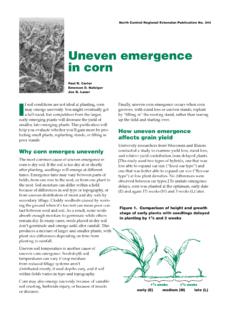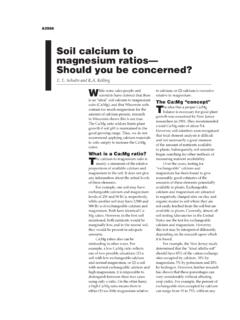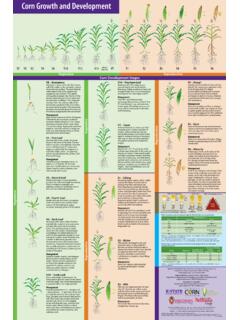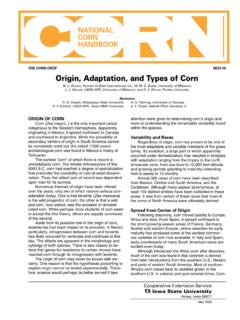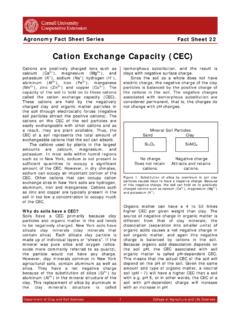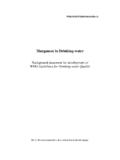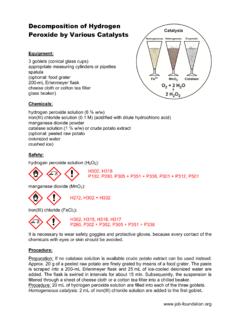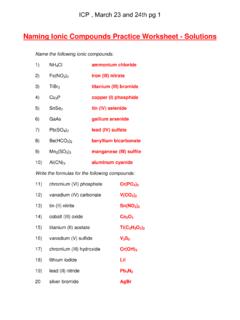Transcription of Soil and Applied Manganese (A2526)
1 Understanding Plant NutrientsSoiland Applied Schulte and KellingManganese (Mn) deficiency andtoxicity have been noted inWisconsin on various soils. Theamount of Manganese in rocks and soilsvaries greatly. Some soils may have asmuch as 3,000 parts per million (ppm) Manganese , yet most of this is unavail-able for plant use. Manganese in rocksand minerals is unavailable to plantsand becomes available very slowly asthe minerals undergo chemical weath-ering. Most available Manganese occursas exchangeable Manganese , manganeseassociated with organic matter, or vari-ous Manganese oxides. Table 1 givesthe Manganese content of some soil -forming REACTIONS IN SOILSIn soil , Manganese occurs asexchangeable Manganese , manganeseoxide, organic Manganese , and a com-ponent of ferro-magnesian silicate min-erals. The Manganese ion (Mn++) issimilar in size to magnesium (Mg++)and ferrous iron (Fe++) and can substi-tute for these elements in silicate min-erals and iron reactions in soils arequite complex.
2 The amount of avail-able Manganese is influenced by soilpH, organic matter content, moisture,and soil pHManganese availability increases assoil pH decreases. Manganese toxicity iscommon in acid soils below pH Onthe other hand, Manganese deficiencyis most common in soils with a pHabove of the main reasons for limingacid soils, especially for legumes, is toprevent Manganese toxicity. The amountof Manganese in solution decreases100-fold for each unit rise in soil pH (asfrom to ). Where manganesedeficiency exists as a result of high pH,it is easier to correct the deficiency byadding a Manganese fertilizer than byattempting to acidify the MatterSoils high in organic matter (morethan ) and near neutral in pH(above pH ) may be deficient inmanganese. As the organic matter con-tent increases, the amount of exchange-able Manganese decreases due to theincreased formation of organic matterand Manganese microorganisms also appear toreduce the availability of Manganese byoxidizing Manganese to less-availableforms and competing with crops foravailable and AerationPoor soil aeration, or reduced oxy-gen level, usually is caused by excessmoisture along with high microbialactivity.
3 High microbial activity con-sumes oxygen when soil temperaturesand supplies of organic carbon arefavorable. As a result, Manganese oxideis transformed to soluble Manganese (Mn++). Under prolonged waterloggedconditions, soluble Manganese leachesout of the soil . Manganese and irondeposits may plug tile lines as drainagewater carrying these elements contactsair in the tile. Temporary waterloggedconditions are conducive to manganesetoxicity; prolonged wet conditions, asin a marsh, can result in SOURCES OF MANGANESEB roadcast applications of man-ganese fertilizer or attempts tobuild soil test Manganese levels are notrecommended, particularly on high pH,high organic matter soils because oftheir capacity to rapidly fix or foliar applications of man-ganese reduce chemical fixation byreducing contact with soil Manganese with ammoniumnitrogen in a fertilizer band furtherTable 1. Occurrence of Manganese in rocks and IGNEOUS ROCKS SEDIMENTARY ROCKS GRANITEBASALTLIMESTONESANDSTONESHALESOIL S ppm ppm ppm 4001,5001,10010 10085020 3,000aSource: Krauskopf, 1972.
4 Geochemistry of micronutrients. In Micronutrients in agriculture, ed. Mortvedt et al., pp. 7 40. Madison, WI: soil Science Society of its availability as a result ofthe acidity produced as ammoniumconverts to sulfate(MnSO4 3H2O) and chelated man-ganese (MnEDTA) are the most com-mon fertilizer sources of Manganese (Table 2). Both are very soluble and areeffective as foliar treatments. However,chelated forms of Manganese are not aseffective as Manganese sulfate for soilapplication. Research with soybean ona Manganese -deficient Sebewa loamshowed that applying manganesechelate to the soil actually increasedthe deficiency. Apparently, the man-ganese chelate converted to the morestable iron chelate. As a result, the soy-bean took in more iron, accentuatingthe iron- Manganese applying a Manganese fertil-izer, sample soils or plants to determinewhether they need this element. Withfoliar applications, two or three appli-cations are sometimes necessary foroptimum response. When soils test lowin Manganese , apply the amount ofmanganese indicated in Table Plant Nutrients2 Table 3.
5 Manganese fertilizer recommendations. MnO or MnSO4 Mn CHELATE CROPSOIL FOLIARSOILFOLIAR lb/a of elemental Manganese Beans (dry, lima, snap), lettuce, oat, , radish, raspberry, soybean, spinach, sorghum-sudan, wheatBarley, beet, broccoli, brussels sprout, cabbage, canola, carrot, cauliflower, celery, corn, cucumber,pea, potato, tobacco, tomato, triticaleOther crops (not listed above)0000aPhytotoxicity may occur if Mn chelate is Applied at a rate greater than lb/a of 2. Fertilizer sources of SOURCEFORMULAMANGANESEM anganese carbonateMnCO331 Manganese chelateMnEDTA12 Manganese chlorideMnCl217 Manganese dioxideMnO263 Manganese oxideMnO41 68 Manganese sulfateMnSO4 3H2O26 28 Manganese DEFICIENCYAND TOXICITYM anganese deficiency is mostlikely to occur in neutral- tohigh-pH soils that are also high inorganic matter. It is common on thered soils of eastern Wisconsin especiallyin low-lying areas and on burned-overorganic soils. Soils high in organic mat-ter with a calcareous subsoil (marl) mayexhibit Manganese deficiency whendrained.
6 Crops with high manganeserequirements include beans (lima,snap), lettuce, oat, onion, radish, rasp-berry, soybean, spinach, sorghum-sudan, and wheat. Those with mediumrelative Manganese needs are barley,beet, broccoli, brussels sprout, cabbage,carrot, cauliflower, celery, corn, cucum-ber, pea, potato, tobacco, and Manganese is found in acidsoils (pH less than ), especiallywhen these soils are low in organicmatter and temporarily , sandy soils are likely to containhigh Manganese levels. Crops suscepti-ble to Manganese toxicity includeasparagus, forage legumes, mint, andpea. Manganese toxicity of potato hasalso been identified on extremely acidsoils (pH less than )DIAGNOSTIC TECHNIQUESD eficiency SymptomsManganese functions as an enzymeactivator for steps in deficiency in oat is knownas gray speck. This is not a pathogenicdisease but a breakdown of leaf speck usually starts as a gray oval-shaped spot on the edge of a new leafwhen the oat plant is in the three- tofour-leaf stage.
7 The speck appears awayfrom the tip and may gradually spreadacross the entire leaf, or many suchspots may wheat and barley, Manganese -deficient plants develop yellow parallelstreaks on upper leaves that run thelength of the leaf. The tip does notremain green as in oat, and the yellow-ing does not start at the tip of wheat orbarley plants as it does with nitrogen orpotassium beans and most non-grain crops, Manganese deficiency appears as inter-veinal chlorosis. The top leaves of defi-cient plants turn yellow in the areabetween the veins while the veinsremain deficiency symptoms,like those of most other micronutrients,often appear in random patterns acrossfields. Rarely is an entire field SymptomsExcess Manganese distorts leavesand produces dark specks on leaves. Insevere cases, leaf tissue begins to die atthe leaf margins and continues backfrom the margins as toxic AnalysisManganese treatment is recom-mended if the soil tests less than 10ppm. When soil organic matter , the availability of Manganese isbased on soil pH.
8 Manganese is recom-mended if the pH is above AnalysisAnalyzing plant tissue provides anaccurate assessment of available man-ganese in soil . It measures how muchmanganese the plant itself gets from thesoil. Plant analysis can also determinehow much Applied Manganese plantsare able to use. Table 4 interprets man-ganese levels for common Plant Nutrients3 Table 4. Manganese plant-analysis interpretations for common Wisconsin crops. INTERPRETATION PLANT PART TIME OF CROPSAMPLEDSAMPLING DEFICIENT LOWSUFFICIENT HIGH EXCESSIVE ppm AlfalfaTop 6 inchesBud<1515 2526 150151 300>300 CornEarleafSilking<1515 2526 150151 200>200 Oat, wheat Top leavesBoot<1010 2526 150151 250>250 OnionTopsMidseason<1010 2021 150151 300>300 PotatoTop leavesFlowering<1010 2021 200201 400>400 SoybeanFirst Trifoliate Early flower<1515 2021 100101 250>250 ADDITIONAL INFORMATIONT hese publications in theUnderstanding Plant Nutrientsseries areavailable from your county Extensionoffice.
9 soil and Applied Boron (A2522) soil and Applied Calcium (A2523) soil and Applied Chlorine (A3556) soil and Applied Copper (A2527) soil and Applied Iron (A3554) soil and Applied Magnesium (A2524) soil and Applied Manganese ( a2526 ) soil and Applied Molybdenum (A3555) soil and Applied Nitrogen (A2519) soil and Applied Phosphorus (A2520) soil and Applied Potassium (A2521) soil and Applied Sulfur (A2525) soil and Applied Zinc (A2528) Copyright 1999 University of Wisconsin System Board of Regents and University of Wisconsin-Extension, Cooperative Schulte is professor emeritus of soil science and Kelling is professor of soil science, College of Agricultural and LifeSciences, University of Wisconsin-Madison and University of Wisconsin-Extension, Cooperative Extension. The authors wish to Walsh, dean emeritus and professor emeritus of soil science, University of Wisconsin-Madison for an earlier edition of this publica-tion. Produced by Cooperative Extension Publications, University of of Wisconsin-Extension, Cooperative Extension, in cooperation with the Department of Agriculture and Wisconsincounties, publishes this information to further the purpose of the May 8 and June 30, 1914 Acts of Congress.
10 An Equal EmploymentOpportunity/Affirmative Action employer, University of Wisconsin-Extension provides equal opportunities in employment and program-ming, including Title IX publication is availablefrom your Wisconsin county Extension office or from Cooperative Extension Publications. To order, calltoll free 877-947-7827 (WIS-PUBS) or visit soil and Applied ManganeseRP-08-2004-(SR 07/99)Understanding Plant Nutrients4
